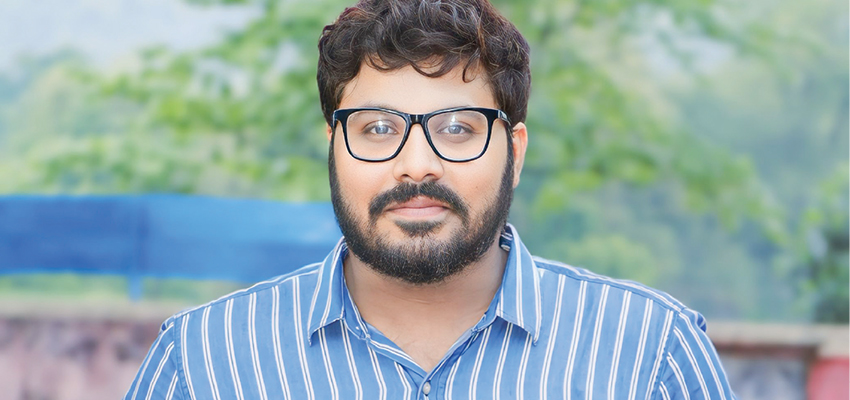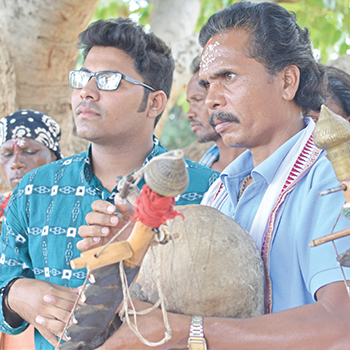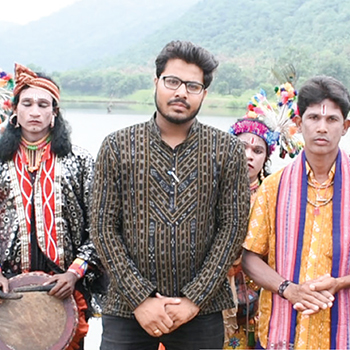Folk Heritage Saviour

A zoology lecturer, Rajat Kumar Panigrahi from Balangir, Odisha, took the responsibility to revive the folk-art forms which were on the verge of extinction. In the last 13 years, Rajat has magnificently revived more than 50 endangered folk art forms from Odisha and Chhattisgarh. He talks Corporate Citizen about his extraordinary journey
It was the time of Maa Samaleswari Chhatar Jatra, organised during the Dussera festival in Odisha, when Rajat first witnessed the holiness and beauty of folk-art forms. He grew up watching festivals being celebrated with folk dance, music and stories. “During my college days, I developed a keen interest in folk art forms. I explored the folk art forms of my village and nearby areas of Nuapada district on my bicycle,” he recalls.
After exploring the villages, Rajat realised that these folk-art forms are their medium of celebrating festivals and their traditional livelihood—the only medium for tribal communities to earn a living. Thus, these tribal communities, as Rajat says, were struggling to sustain their folk-art forms and as a result they were fading. Rajat decided to help these tribal communities in anyway he could. “I started teaching children to earn money, saved my pocket money, and financially assisted them so they could earn their livelihood,” he says.
Exploring folk-art forms

In 2014, Rajat started working as a lecturer in Yuvodaya College, Balangir, which helped him financially to achieve his objective of helping the needy folk artists and tribal communities. He went on to explore more than 400 villages in Odisha and learned about different folk-art forms in the state. He says, “It was extremely difficult for me to convince these tribal communities to promote their folk instruments in the public exhibitions, conducted in big cities, because they lack funds to manufacture the instruments. So, I used to provide half of my salary to help them design the folk instruments”. He is actively working with 20 villages to preserve their folk-art forms.
The idea of providing financial aid worked well, and Rajat succeeded in showcasing these folk instruments at exhibitions. Apart from this, he also helps the folk artists in connecting with potential buyers. “I used to share photos, videos, and details of the folk artefacts made of terracotta, old wooden crafts, and folk instruments with my friends so that anyone interested can purchase the instrument from these tribal communities,” he said.
With the continuous efforts, as Rajat says, the sales of the folk artefacts escalated from 5 instruments to 30 instruments in a month. Out of 20 types of folk instruments in Odisha, at least 10 instruments, including Sarangi, Jogi Jantra, Muhuri, Nisan, Mandal, Mitu Thant, and Humbo Baja, were on the brink of disappearing. However, today, these folk instruments have been revived and gradually coming into the limelight. They are typically made of bamboo or wood in the form of string or percussion instruments.
Adventures of Rajat
Being an admirer of folk songs and folk dance, Rajat also wanted the world to perceive them. This led him to start a YouTube channel, ‘Matir Kala’. He started this channel in 2017 along with his cousin Satyanarayan Panigrahi and his dear friend Ganesh Pradhan, who helps him with recording and editing the video.
In order to collect data for his YouTube channel, he visited different parts of Odisha and recorded different folk art forms. Sharing an incident during his excursion to Niyamgiri hill range, situated in the districts of Kalahandi and Rayagada in Odisha, he says, “I was fascinated by the folk stories of the Indigenous Dongaria Kondh tribe at Niyamgiri hills. This tribal community worships their deity, Niyam Raja, singing folklore and dancing to the beats of folk instruments. “One day, my team and I visited the village to record their celebrations without any research or prior information. After seeing us there, the tribal community severely attacked us”. He adds, “We saved ourselves and our videotaping equipment and sought help at the local government office. There we learnt that some foreigners bullied them earlier, leading to the attack”.
Rajat recalls, “Later, with the help of local administration, we were able to visit the place and record their worship rituals, folk songs, and dance. When we returned, they greeted us with a gift that they had made themselves".
Family support
For the past 10 years, Rajat has been dedicated to preserving folk art forms, and he credits his parents and wife for their support. Earlier, when he trod on this expedition, his family members and relatives refrained him from pursuing his passion. However, he continued his work, and over time, his family has come to recognise the value of his work, and they now fully support and encourage him. He says, “After a year or two, my father realised that the work I’m doing is for the welfare of society, so now everyone in my family is behind me”.
"With the continuous efforts, the sales of the folk artefacts escalated from 5 instruments to 30 instruments in a month. These folk instruments have been revived and gradually coming into the limelight"
-Rajat Kumar Panigrahi
Encourage youth participation

Rajat and his team are taking a step forward to reviving folklore, folk art, and folk music through teaching it to the youth. Rajat believes that the best way to revive this art is by connecting youth with the tradition. The team conducts sessions to teach folklore and folk music to the young students. The team conducts sessions to teach folklore and folk music to the youth, while offering free instruments like Dhunkel to encourage them to learn. “All these initiatives are the brainchild of me and my two teammates. We do not believe in seeking support from any NGO, because that would deviate us from our objective,” Rajat expresses.
The museum project
After going digital in 2017, Rajat has been awarded with a total of 20 accolades in the field of art and culture for preserving more than 50 types of folk art forms in Odisha and Chhattisgarh. With preserving these rich heritages, Rajat is also establishing a museum wherein he will showcase all the folk art forms from across Odisha. The museum will be located in his birthplace at Raj Komna village and will soon be open to the public. “Travelling for more than one lakh kilomteres, visiting 1,500 villages to remote areas, to hills, and connecting with 20,000 tribal people, I have recorded their folk stories, music, and art. Now my goal is to showcase the beauty and holiness of these folk art forms in the museum, spreading awareness and ensuring that these arts are not forgotten over time,” he concludes.